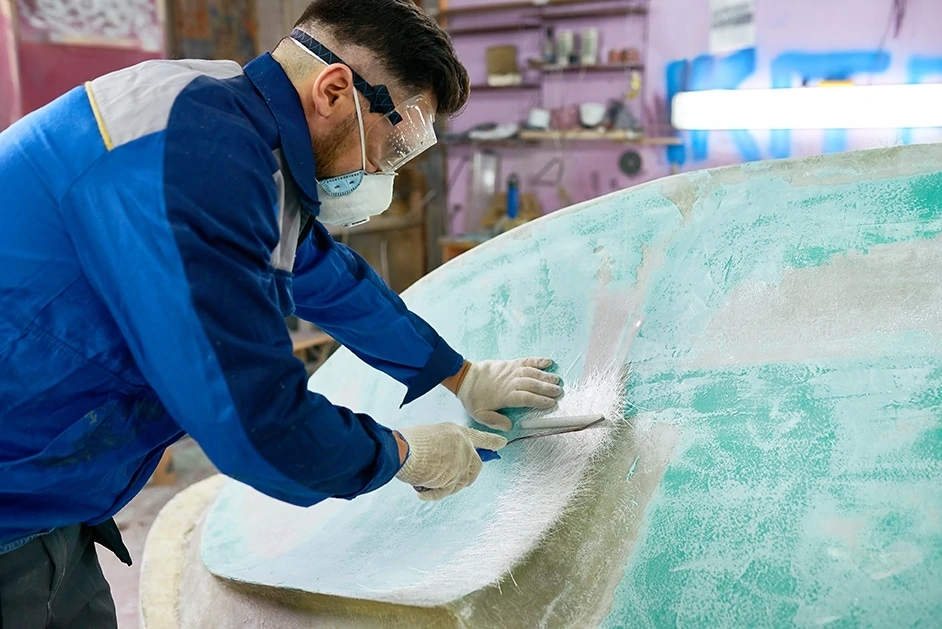Marine Epoxy Resin and Paints – Your complete Guide
This post may contain affiliate links. We may earn a small commission from purchases made through them, at no additional cost to you. You help to support resin-expert.com
In order to choose the correct epoxy, you need to look at what materials you will be working with. If for example you will be working on a project which will be submerged in water or have frequent exposure to water you would need to use a marine-grade epoxy. Examples of such projects would be repairing of pipes or repairs to boats or an assortment of other projects. Each type of epoxy has its own unique features and these each have their own set of pros and cons. It is important to do the necessary research and have the sufficient insight to select the correct marine epoxy resins that match your requirements.
Table of Contents
What is Marine Epoxy Resin?
As previously mentioned, you use marine epoxy resins on projects that will be frequently exposed to water. Items include underwater pipes or even a boat hull which are both submerged in water. It is important to use epoxy resin which is going to be long lasting and it reliable, particularly as it will be exposed to harsher environment.
Your marine epoxy resin becomes waterproof when it has completely set and provides significant strength.
Choosing the correct Marine Epoxy resin
It is important to take a few facts into consideration when you are purchasing your marine grade epoxy resin. You can purchase the product as a form of a paste or a thick liquid. The thick paste comes with a hardener. When you use the thick liquid option, you will need to get a filler powder and this allows you to thicken the product when you need to.
To help chose the right product you need to take the following into consideration:
- Firstly, it is imperative to select the best suited epoxy for the project at hand.
- Your best choice is the liquid epoxy with the necessary filler. The reason for this is this type of product is ready to use when you need it and is therefore great in an emergency.
- You might find you encounter problems if you use product which has expired. Always double check the shelf life of an epoxy resin product.
- Equip yourself with the relevant information prior to beginning your project. You will find out about polyester resin. This is also considered a resin however isn’t as long lasting and as strong as the epoxy resin.
- Always stick to the instructions when you are mixing your epoxy resin and hardener. Particularly make note of the time you have to work with the epoxy resin. Also take note of any aspects which relate to the temperature and or humidity as this impacts the substance.
- Most importantly remember to wear the necessary safety gear when working with epoxies. You will require gloves and eye goggles. Also make sure you have mixing sticks and containers at hand.
Marine Epoxy resins
Marine Epoxy Resin Applications
Epoxy resins are wonderful for a number of applications as they are all similar in that they all have coating, sealing, bonding and water-resistant properties. The assortment of type of resin you get are art resins, tabletop resins and the clear marine epoxy resin. You would use the marine-grade epoxy resin for maintenance projects and structural boat repairs.
The marine-grade epoxy resin can be used in conjunction with a number of materials such as:
- PVC
- Fiberglass
- Ceramic
- Wood
- Concrete
- Types of Plastic
- Certain Metals
Pros
- Significant bonding and adhesion properties
- Can create a bond with a number of surfaces
- Durability and overall strength
- Limited shrinkage when setting
- Only a few toxic hardeners
- A long shelf life
- Very resistant to moisture and sustains limited damage
Cons
- Has a very low resistance to UV
- When applied to a Gelcoat it may not bond sufficiently
- The product is very pricey
- You have to be very careful with your measurements when combining the resin and hardener
- During the application process it is very susceptible to environmental changes.
Casting Resin
When casting molds you would use casting resin and it is particularly popular to be used for making resin jewelry. This type of resin a lot thinner than that of your coating resin. Each form of application requires a different mixing ratio. As the epoxy resin has a slow setting time it allows you more time to work with the product. The casting epoxy resin can be used when doing industrial applications, examples of which include:
- The laminating of surfaces
- Enclosing items
- When you need to fill in any spaces or gapes in wood
Coating Resin
This type of resin is used for coating items and can also be used for providing a surface for floors and ceilings. The coating resin assists in bonding, coating and sealing objects. This particular type of resin is a little thicker than the casting resin and therefore has a faster curing time. The mixing ratio for the coating resin is however easier.
The epoxy coating resin gives you a clear finish and can be used for items such as:
- Overlaying of furniture and other such items
- Boat decks and surfboards
UV Resin
If you would like to have immediate results and not waiting before the cure process starts and everything is hardened, you can also use UV Resin.
UV Resin Applications
You can find UV Resins available to purchase. UV resin can also be used when doing smaller projects such as the making of resin jewelry. UV resin is great as an epoxy resin adhesive and is useful to seal small areas.
Pros
- There is no tiresome mixing process
- You do not need to hurry when working with it, as it has a long processing time
- However, should you wish to fast cure it you can do this with the use of a UV light
Cons
- The shelf life of UV resin is only 6 months, which is relatively short
- When applying UV resin, you will need to do it in thin coats and you will need to do several layers
- In order to cure the product correctly you will require a UV lamp
- It is a very pricey product and definitely more expensive than that of standard epoxy resin
Polyester Resin
Polyester resin is made up of unsaturated synthetic resins which is a combination of a number of different polyesters. The composite industry uses a significant amount of polyester resin.
Polyester Resin Applications
You can use polyester resin for a variety of different projects and it has many applications. This type of resin is very popular when repairing plastic items and within the boat building industry. Some of the key uses include the sealing of swimming pools and Jacuzzis.
You are able to use this polyester resin in a number of outdoor construction projects that need the materials used to be water-resistant.
Pros
- You can control the setting time through the amount of hardener you add to the polyester resin. It is important to ensure the measuring and weighing is done correctly to get the desired result.
- Polyester resin is a very affordable product
- There are options of reinforcing fabrics for your relevant building projects such as fabrics or glass fiber mats
- The time you have to design with is significantly more flexible.
Cons
- There is a distinct smell which is given off during processing
- This type of resin has a high shrinkage rate
- You will find that polyester resin does not bond to smooth surfaces such as metal or glass
- Polyester resin falls short when compared to epoxy resin, particularly as it is not as durable or water-resistant
Polyurethane Resin
This particular kind of resin is also a synthetic resin and is a type of plastic. Polyurethane resin has a number of application options and it is very versatile. You are able to alter the resin to create materials that are rigid or hard or pliable.
The majority of polyurethane resins can be purchased in a liquid form that you can then pour into your mold. You are also able to add fillers or additives to the polyurethane resin that then creates the properties you require in your completed project.
Polyurethane Resin Applications
As mentioned, the polyurethane resin is very versatile and can be used in home DIY projects and in an industrial environment. Here are a variety of options for polyurethane resin applications:
- The coating of floors
- Mold casting and the casting of tires
- You are able to create adhesives and other coatings as well as paints from polyurethane resin
- Production of foam
- You are able to encapsulate electronic parts and components
Pros
- The workable viscosity of this resin makes it easier to cast and shape it as required
- This particular type of resin is very easy to work with
- It hardens quickly
- You do not have to wait a long time before de-molding an object
- Once the resin has cured it then has a high resistance to heat
- During the curing time there is very little shrinkage
- The resin easy combines with a variety of fillers and additives
Cons
- Once the product has been cured you are unable to weld it
- In order to increase its UV resistance, you will be required to add additives
- When curing the product does give off emissions and odors
- The polyurethane resin is very moisture sensitive and therefore this element decreases its durability
- When compare to epoxy resin, the adhesion properties are not as good
Marine epoxy paint
When you have completed your maintenance project or boat repair you can use marine epoxy paint to make it look good. The majority of marine epoxy paints are created to be effective for exterior applications. Using this type of paint adds a layer which offers protection and helps the surface handle extreme conditions while also making it water resistant.
To being with you will have to clean the surface area where you wish to paint. You will have to sand down the clear marine epoxy until it becomes dull and then you will have to wipe off the surface. Next you can then apply the marine epoxy primer. You will need several coats of the marine epoxy primer. Your last step is to layer your marine epoxy paint over the primer. Remember to add at least two layers of paint.






